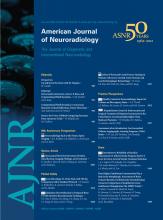The recent article by Ha et al published in the American Journal of Neuroradiology1 has rekindled the debate sparked by previous studies2⇓–4 that had linked atypical brain MR imaging findings to the nonalcoholic (NA) variant of Wernicke encephalopathy (WE). In unselected patients with WE, the anatomic regions most frequently involved by MR imaging are the medial thalami and the periventricular regions of the third ventricle.3 However, atypical MR imaging findings may also be observed, including symmetric alterations of the cerebellum, cerebral cortex, and cranial nerve nuclei (CNN).3,4 Atypical MR imaging findings usually occur in association with the typical MR imaging findings of WE.5 In the largest case series published to date encompassing 56 patients with WE, we detected atypical MR imaging changes more commonly in NA compared with patients with alcoholism (AL).4 In particular, involvement of CNN was seen in 32% of NA versus none of the AL patients.
In contrast to our findings, Ha et al1 found no significant differences in the distribution of typical and atypical MR imaging findings in AL and NA patients with WE. Both their1 and our studies are retrospective in design, and thus prone to incurring a selection bias due to the lack of predefined entry criteria. Therefore, the study populations may differ in some characteristics that cannot be determined a posteriori.
There are, however, some differences in the studies that may help to explain, at least in part, their different conclusions. First, our study included more than twice as many patients as the study by Ha et al.1 Sample size is invariably a critical issue because all other things being equal, studies with larger numbers of patients are more likely to arrive at significant results than those with fewer patients. In particular, if we consider only NA patients, our study included 3 times as many patients (n = 30) as the study by Ha et al (n = 11). Second, in our patients, MR imaging was performed in the acute stage of WE, whereas in the study by Ha et al, the mean interval between the onset of manifestations and performance of MR imaging was 4.5 days. This delay may have potentially resulted in some differences in the brain changes depicted by MR imaging. Third, 43% of our patients fulfilled the classic diagnostic triad of WE compared with 17% of the patients investigated by Ha et al, suggesting that our patients may have had, on average, more severe disease and thus a higher likelihood of having abnormal MR imaging findings. Fourth, Ha et al did not specifically identify CNN lesions except in 1 NA patient with involvement of CNN IX. However, they did show that 14 NA patients and 10 AL patients had active lesions in the dorsal medulla or in the periventricular gray matter of the fourth ventricle, which are sites where many CNN are located.1 Therefore, although CNN were not formally identified in the study by Ha et al,1 the findings of their study may, nevertheless, support the concept that CNN involvement is more common in NA patients, in agreement with our own3,4,6 and the findings of others.2,7 The involvement of CNN IX reported by Han et al is a particularly intriguing finding, both because this specific CNN has not previously been shown to be involved in WE4,8 and because CNN IX is notoriously difficult to distinguish from neighboring nuclei. It would be interesting to have a chance to review the images on the basis of which CNN IX involvement was diagnosed.
We concur with Ha et al1 that thiamine deficiency is a crucial component in the pathogenesis of WE and that prompt treatment with thiamine can avert a dismal prognosis. At risk patients should thus receive thiamine regardless of whether they are hospitalized. However, we would also like to suggest that other factors, including alcohol intake, may modulate the expression of WE.5 Until data from prospective studies become available, we think that the current body of evidence still supports the notion that MR imaging findings in NA patients differ, at least in part, from those of AL patients with WE. Most important, both our study4 and the one by Ha et al1 clearly demonstrate that the spectrum of radiographic alterations is broader than that of “classic” changes. Therefore, radiologists should be aware that WE may present with both typical and atypical findings. At least equally important, despite the partial discrepancies in the results published, the role of MR imaging in clinching an early diagnosis of WE is fully confirmed.
References
- © 2012 by American Journal of Neuroradiology












